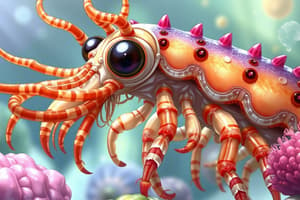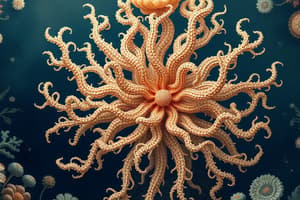Podcast
Questions and Answers
Which marine invertebrates are the backbone of coral reefs?
Which marine invertebrates are the backbone of coral reefs?
- Anemones
- Jellyfish
- Corals (correct)
- Sponges
What phylum do corals belong to?
What phylum do corals belong to?
- Annelida
- Mollusca
- Cnidaria (correct)
- Echinodermata
Which marine environment exceeds tropical rainforests in terms of biodiversity?
Which marine environment exceeds tropical rainforests in terms of biodiversity?
- Deep sea vents
- Open oceans
- Coral reefs (correct)
- Polar seas
What is the economic value provided by coral reefs?
What is the economic value provided by coral reefs?
Which phylum includes sponges?
Which phylum includes sponges?
Which phylum dominates marine invertebrates along with Cnidaria and Porifera?
Which phylum dominates marine invertebrates along with Cnidaria and Porifera?
What type of symmetry do cnidarians exhibit?
What type of symmetry do cnidarians exhibit?
Which phylum is characterized by segmented bodies?
Which phylum is characterized by segmented bodies?
What is the main distinguishing feature of echinoderms?
What is the main distinguishing feature of echinoderms?
Which marine invertebrates serve as the base of coral reef ecosystems?
Which marine invertebrates serve as the base of coral reef ecosystems?
What do marine invertebrates provide to coral reefs?
What do marine invertebrates provide to coral reefs?
Which phylum includes animals like freshwater sponges and bath sponges?
Which phylum includes animals like freshwater sponges and bath sponges?
Study Notes
Marine Invertebrates: Focus on Coral Reefs and Phyla
Marine invertebrates, those without backbones, play essential roles in the undersea realm. Among them, coral reefs stand out as some of the most complex and productive ecosystems on Earth. This article explores coral reefs and the various phyla of marine invertebrates that inhabit them.
Coral Reefs
Coral reefs are built by colonial, sessile organisms known as corals. These marine invertebrates belong to the phylum Cnidaria, which also encompasses jellyfish and anemones. Corals are the backbone of reefs, forming intricate structures that house a vast array of species. Reefs support more diversity than any other marine environment—even exceeding tropical rainforests in terms of biodiversity.
Coral reefs are crucial to the marine world. With around 70,000 species worldwide, they provide refuge for countless organisms and serve as nurseries for juvenile fish. Their importance extends beyond ecology, as reefs also offer significant economic value through fishing, coastal protection, and tourism.
Phyla of Marine Invertebrates
Six main phyla dominate the marine invertebrate kingdom: Porifera, Cnidaria, Echinodermata, Mollusca, Annelida, and Crustacea. Let's explore the key characteristics and examples for each of these groups:
Porifera (Sponges)
Porifera are composed of porous structures and consist of simple, multicellular organisms. They lack true tissues and organs, instead having specialized cells that create a network through which water flows. Examples include freshwater sponges and bath sponges.
Cnidaria (Corals and Jellyfish)
Cnidarians exhibit radial symmetry, meaning their body plan revolves around a central point. They possess a mesoglea (jelly-like substance) between their epidermis and gastrodermis layers. Examples include corals, anemones, and jellyfish.
Echinodermata (Sea Stars, Urchins, Brittle Stars)
Characterized by pentaradial symmetry, echinoderms are mostly marine and include animals like starfish, sand dollars, and sea urchins. They have a durable external skeleton called a test, which provides protection and structural support.
Mollusca (Snails, Clams, Squids)
Mollusks are the second largest phylum in the animal kingdom, featuring bilateral symmetry and a soft body. They have a muscular, unsegmented foot for locomotion and a radula, a tooth-like appendage for eating. Examples range from bivalves like clams to cephalopods like squids.
Annelida
The phylum Annelida consists of annelid worms, characterized by their segmented bodies. They primarily dwell in marine environments, but some can be terrestrial or even aquatic. Annelids include leeches, earthworms, and ragworms.
Crustacea
Crustaceans are arthropods with an exoskeleton that they periodically shed. They live in both freshwater and marine environments, with representatives like crabs, lobsters, and shrimp. Crustaceans are distinguished by their jointed legs and segmented bodies.
Interdependence Between Coral Reefs and Marine Invertebrates
Coral reefs serve as homes, nurseries, and feeding grounds for countless marine invertebrates. For example, certain phyla like Platyhelminthes and Nemertea depend on the reefs for habitat and protection. Similarly, corals themselves are invertebrates that form the base of these complex ecosystems. Furthermore, many coral reef species are threatened due to environmental factors such as climate change, pollution, and overfishing.
In conclusion, marine invertebrates are diverse inhabitants of our seas, playing crucial roles in the maintenance and functioning of coral reefs. Each phylum brings its unique contributions to these delicate ecosystems, highlighting the importance of conservation efforts to safeguard the health and stability of marine life everywhere.
Studying That Suits You
Use AI to generate personalized quizzes and flashcards to suit your learning preferences.
Description
Explore the fascinating world of marine invertebrates, with a focus on coral reefs and the diverse phyla that inhabit them. Learn about the essential roles these creatures play in underwater ecosystems and the interdependence between coral reefs and marine invertebrates.




